Breed all about it - A tribute to the Golden Retriever...
Published by SignalPET on February 01, 2021
.jpeg?width=850&name=t_golden%20(1).jpeg)
February 3rd is the National Golden Retriever Day! This day is celebrated by many retriever fans all over the country. Celebrations recorded have been as small as a special treat for an owner’s special Golden, to as big as a 1000 Golden Retriever gathering on February 3rd, 2019 (pre-pandemic restrictions).
The Golden Retriever is one of the most popular dog breeds in the United States. The breed’s even temperament and affectionate nature makes them the perfect pick for a family pet. The American Kennel Club lists the Golden Retriever as the third most popular breed (based on 2019 registration statistics). Their intelligence, great sense of loyalty, and quick and consistent response to training has made them the most common breed trained as service dogs.
As with other breeds of dogs, the Golden Retriever can develop ailments that are considered more common for the breed. We wanted to take the time to review some of these diseases with special attention to those that have radiographic changes associated with them.
Golden Retriever health concerns and the radiographic signals
Goldens are generally healthy, but like all breeds, they are prone to certain health conditions. While not all Golden Retrievers will get any or all of these diseases, it is nonetheless crucial for veterinarians and owners alike to be aware of them. SignalRAY is working together with veterinarians to be able to identify and diagnose many of these conditions:
Hip and Elbow Dysplasia
The Golden Retriever Club of America strongly recommends that all U.S. breeding dogs have screening tests performed to determine their status in regard to the following potentially inherited conditions: hip dysplasia, elbow dysplasia, inherited eye disease, heart disease, and NCL (neuronal ceroid lipofuscinosis). With respect to Hip and Elbow dysplasia: A report from the Orthopedic Foundation for Animals (OFA) or PennHIP at 24 months of age or older is recommended to evaluate the hips. And a report from OFA at 24 months of age or older is recommended for the elbows.
SignalRAY offers the following screening apps: Hip Osteoarthritis, Elbow Osteoarthritis.
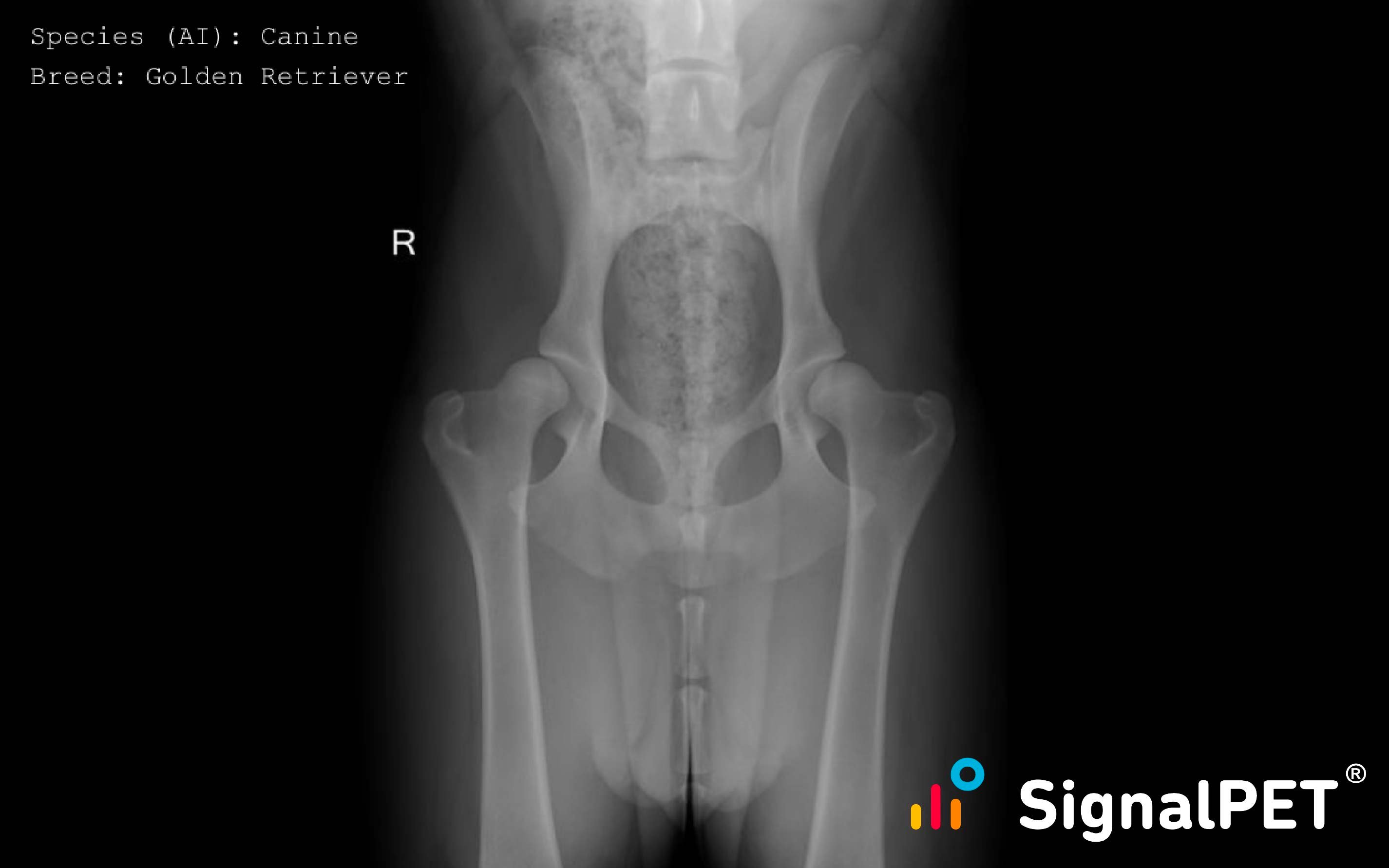 Hip Osteoarthritis in a Golden Retriever
Hip Osteoarthritis in a Golden Retriever
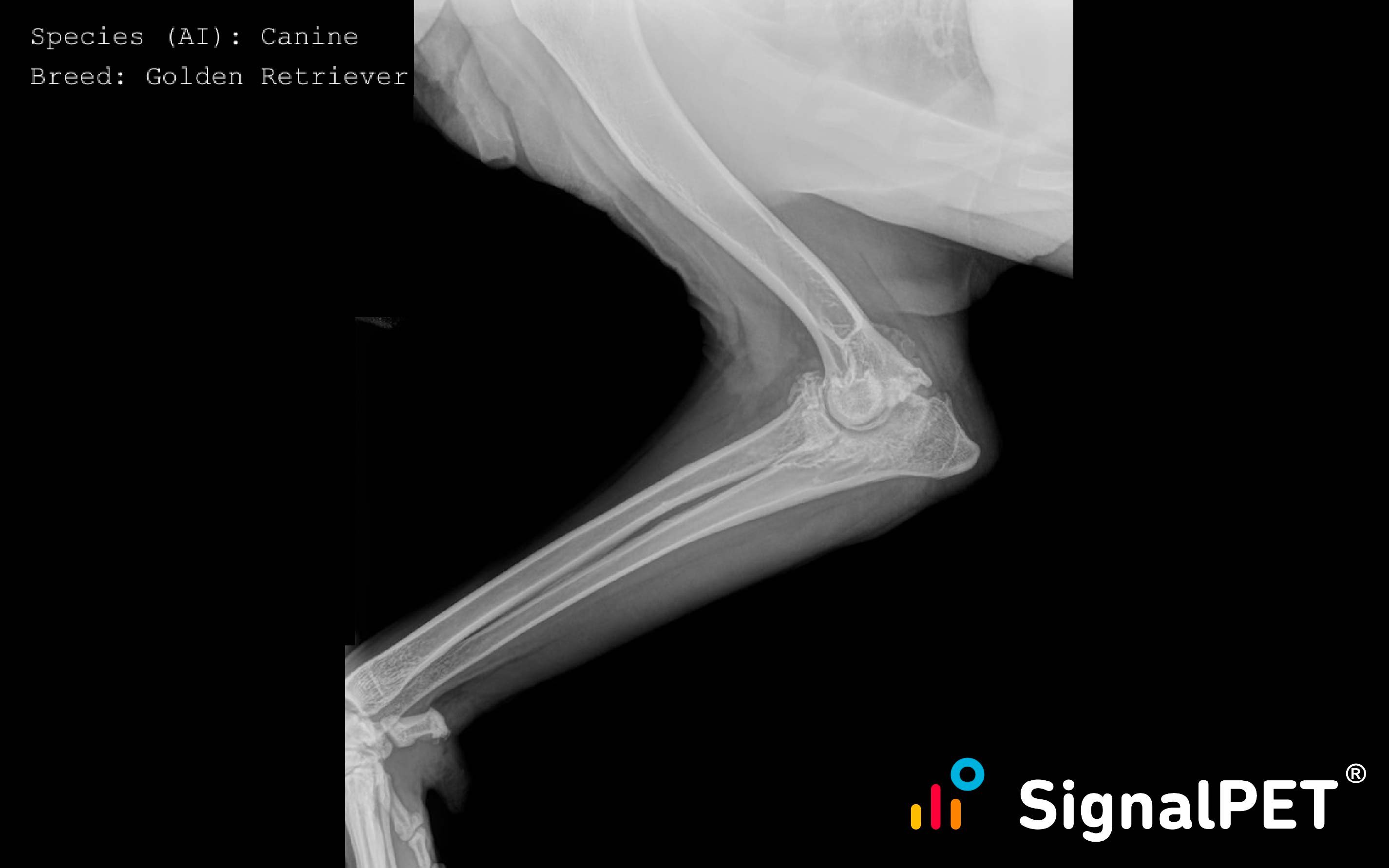 Elbow Osteoarthritis in a Golden Retriever
Elbow Osteoarthritis in a Golden Retriever
Osteochondrosis Dissecans (OCD)
Osteochondritis dissecans (OCD) frequently occurs more in large and giant breeds. Commonly affected breeds include Labrador Retrievers, Golden Retrievers, Newfoundlands, Bernese Mountain Dogs, Chow Chows, German Shepherds, Mastiffs, Old English Sheepdogs, Rottweilers, and Standard Poodles. Most dogs will start showing clinical signs as young as 4 to 7 months of age. Most are recognized to have a lameness that becomes worse with heavy exercise and after prolonged rest. In some cases, no obvious affected leg can be determined, as osteochondritis dissecans can occur in both limbs.
SignalRAY is currently working on training AI to identify flattened humeral heads.
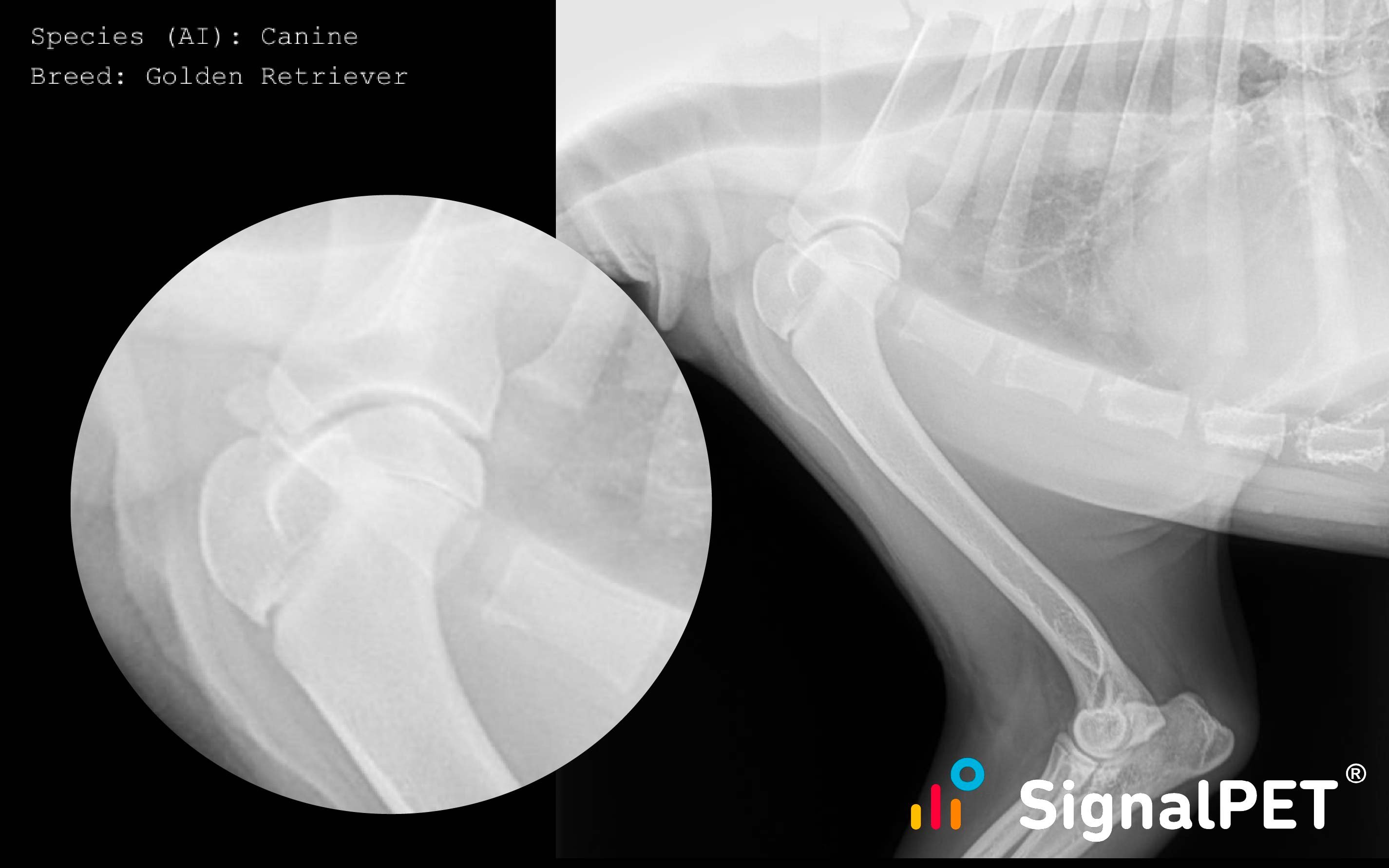 Osteochondritis Dissecans in a Golden Retriever
Osteochondritis Dissecans in a Golden Retriever
Gastric Dilatation-Volvulus
GDV is an acute, life-threatening condition that primarily affects large and giant-breed dogs, with a mortality rate of 20% - 45% in treated animals. Immediate medical and surgical intervention is required to optimize survival in patients with GDV.
SignalRAY is able to identify GDV in our patients with gastric dilatation and volvulus test.
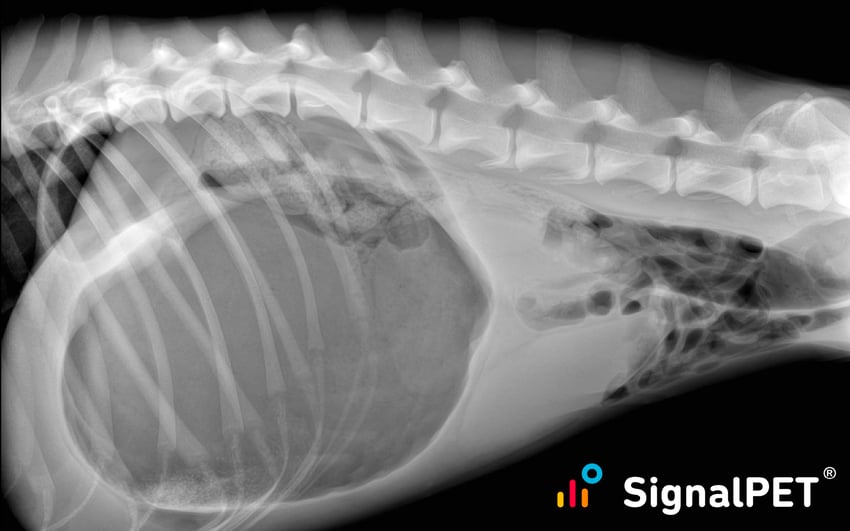 Gastric Dilatation-Volvulus in a Golden Retriever
Gastric Dilatation-Volvulus in a Golden Retriever
Hemangiosarcoma
Hemangiosarcoma is a cancer dreaded by all Golden Retriever owners and veterinarians.Hemangiosarcoma most commonly affects the spleen and heart of Golden Retrievers, Labrador Retrievers, and German Shepherds. It is estimated 25 percent of dogs that present with splenic hemangiosarcoma also have a tumor of the heart. It is recommended that all suspected patients are screened (3-view thoracic radiography) for cardiac/pulmonary metastasis.
SignalRAY can offer assistance in diagnosing neoplastic processes such as hemangiosarcoma with the following tests: pulmonary mass, pulmonary nodule, cranial thoracic mass, abdominal mass effect, and splenomegaly.
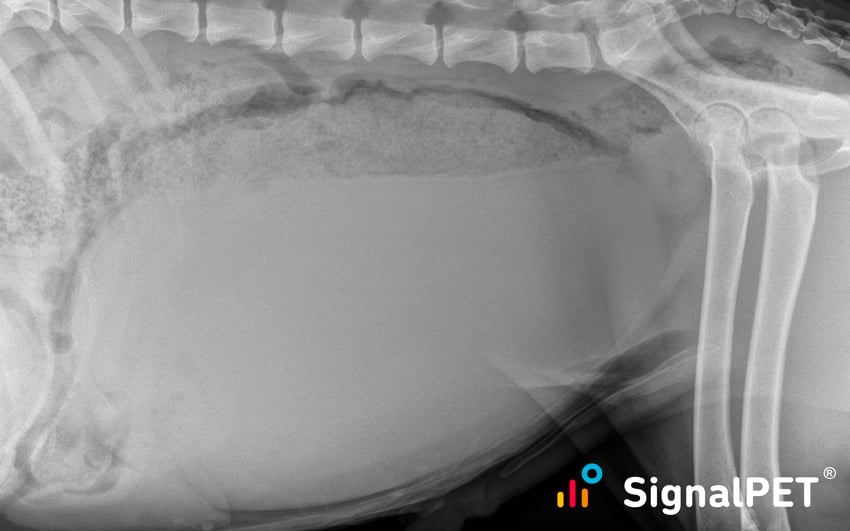 Hemangiosarcoma in a Golden Retriever
Hemangiosarcoma in a Golden Retriever
Osteosarcoma (OSA)
Osteosarcomas appear to affect large breed dogs more commonly than small breeds. Among Golden Retrievers, other breeds with a high predisposition include: Boxers, Doberman Pinschers, German Shepherds, Great Danes, Great Pyrenees, Greyhounds, Irish Setters, Irish Wolfhounds, Rottweilers, Saint Bernards, and Weimaraners. The most common predilection sites for osteosarcomas in dogs are the radius/ulna and the tibia/fibula. OSA can, however, occur in any bone.
SignalRAY is able to identify primary bone neoplasms such as osteosarcoma with the test for aggressive bone lesions.
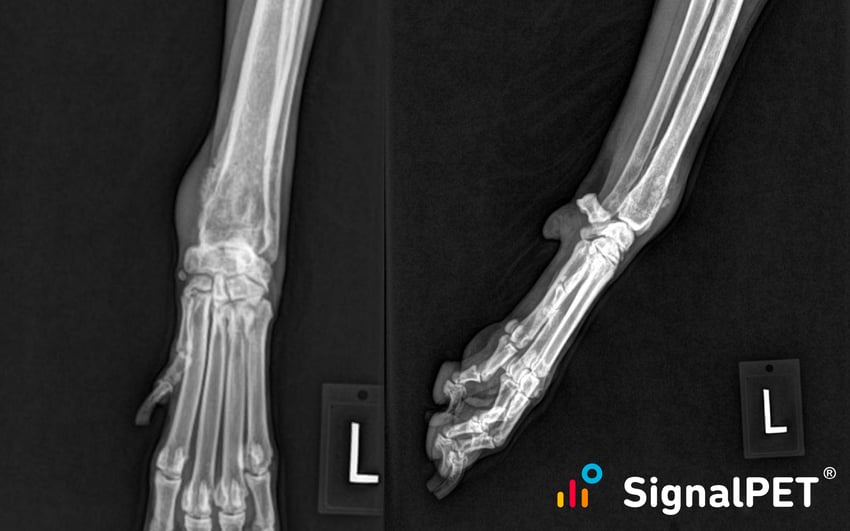 Osteosarcomas in a Golden Retriever - 1
Osteosarcomas in a Golden Retriever - 1
 Osteosarcomas in a Golden Retriever - 2
Osteosarcomas in a Golden Retriever - 2
Subvalvular Aortic Stenosis
Subvalvular aortic stenosis (SAS) is the most common congenital heart disease in Golden Retrievers, Newfoundlands and Rottweilers. In many cases, affected dogs do not show any signs - as such, SAS has a history of taking the lives of seemingly healthy dogs. While echocardiology is the most sensitive test for diagnosing aortic stenosis, chest radiographs do have their place in the emergency setting in diagnosing the heart failure associated with severe cases (radiographs often show enlargement of the left side of the heart and a visible bulge of the aorta). Chest radiographs may look normal early in the course of the disease, or in dogs that are only mildly affected.
SignalRAY may be helpful in identifying an enlarged heart with its VHS calculation or can identify evidence of pulmonary edema with its test for a caudodorsal parenchymal pattern.
